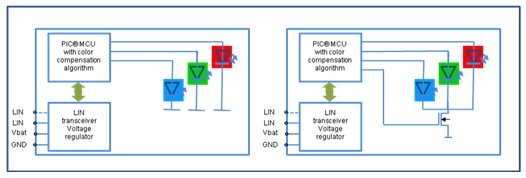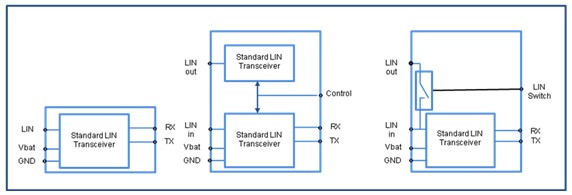While car OEM interior designers are looking to increase product value and increase car appeal, they are also committed to creating a positive driving experience and increasing brand awareness. Together, these factors have laid the foundation for the rapid development of LED ambient lighting solutions. Electronic devices continue to be the fastest growing segment of automotive components, surpassing mechanical, pneumatic and hydraulic devices. Automotive OEMs have illuminated white and colored LED environments as the number of LED ambient lighting applications continues to increase (from cluster backlights to cup holders to map lights, pedal space and context lighting for door trims, and Ceiling Lights) The solution is differentiated. In fact, research shows that lighting can enhance the driver's vision.
Choosing the right embedded solution is still critical to match application requirements and achieve cost-effective and time-to-market designs. This article will delve into the following:
1. Trade-offs between methods of controlling LED ambient lighting solutions
2. Use control algorithms to achieve effective pixel merging, dimming, and temperature compensation for LED colors
3. Create driver-preferred lighting scenes by changing the color and brightness of the LED array
As the demand for networked lighting modules continues to grow, implementing best practices for LIN communications in LED ambient lighting solutions can help reduce development costs and shorten development cycles. Because LEDs consume less energy and take up less space, automotive fuel efficiency will increase, and designers can take advantage of LED packaging to extend their creativity into lighting, thereby improving the in-car experience.
Overall, LED ambient lighting solutions give OEMs the opportunity to create a comfortable atmosphere for drivers and passengers.
LED ambient lighting is far more than its novel features. In the past few years, research on the effects of interior lighting has not been noticed, and the focus of research and development has been on exterior lighting. This situation is changing. With the rapid development of LED technology in recent years, OEMs have not only been able to provide more colorful interior lighting, but also provide user-adjustable lighting. In this way, the driver can adjust the lighting according to personal emotions or tastes. In addition, interior lighting has greater potential.
In future models, interior lighting is very likely to be part of the advanced driver information system. This innovative idea is to adjust the interior lighting according to the driving situation. For example, when a car is driving in a city, on a country road, or on a highway, the color of the interior lights will vary. Red interior lights enhance the driver's alertness in the city, while yellow interior lights help the driver relax while driving on the highway. The interior lighting can even remind the driver that an accident may occur. In many cases, flicker-free interior lighting is tied to the high-value positioning of automakers to differentiate their products in an increasingly competitive environment.
Drive LED
The LED must be driven with a constant current source. Most LEDs have a specified current level at which the LED can reach maximum brightness without premature failure. The light energy output of the LED is proportional to the current passed. There are two ways to control the brightness of the LEDs in the circuit. One is to change the LED drive current. The LED drive current can be controlled by a variable resistor or variable voltage supply. Another method is to apply pulse width modulation (PWM) or a variable frequency but fixed duty PWM to the LED drive current.
The first method has two main drawbacks: as the current decreases, the LED efficiency may also decrease. Moreover, in high power white LEDs, a reduction in current level can result in color deviations. PWM dimming technology always drives LEDs at full current. Therefore, problems such as efficiency reduction and color deviation can be eliminated. In order to produce different color combinations, the duty cycle of the PWM output needs to change over time.
Color control method
Using embedded microcontroller technology, it is possible to detect and actively control the color components of the light source. Active color control can be used to generate specific light colors, as well as to produce mixed colors. For example, a plurality of constituent colors can be mixed to produce a specific quality of white light.
The desired color is produced using three color values ​​representing red (R), green (G), and blue (B), respectively, and another value representing brightness. Three PWM channels can be used, or four PWM channels (three of which represent three colors, and the other four represent brightness) are implemented, which is simpler and more efficient. The latter method is adopted by Ford Motor Company's latest model for providing situational lighting.
The method of uniformly controlling color and brightness using three channels typically requires 14- to 16-bit resolution and a powerful microcontroller (MCU). The same quality can also be achieved with four channels with a resolution of 10 bits, which are typically provided in low cost 8-bit MCUs. In a four-channel scheme, the product of color and luminance is calculated by an external hardware circuit. A typical logarithmic gradient required for brightness control can also be implemented with a power function approximation on a low-cost 8-bit MCU (see Figure 1).

Figure 1 Block diagram of a solution with 3 and 4 PWM channels
LED temperature is one of the factors that have a significant impact on LED color. Therefore, it is necessary to compensate for the effects of temperature. An inexpensive, simple, and effective method of temperature compensation is to use an on-chip comparator of a microcontroller and a low-cost negative temperature coefficient (NTC) thermistor located near the LED. Another way to obtain LED temperature control is to measure its forward voltage drop. The resolution of the 10-bit analog-to-digital converter (ADC) integrated with the microcontroller is sufficient for this task. Positive pressure drop measurements have certain advantages because no additional external components are required.
Lighting network
Color correction, temperature compensation, color change, color mixing, brightness control, and automotive manufacturers' expectations for various lighting scenarios are necessarily used with microcontrollers such as PIC® MCUs with non-volatile memory. In addition, the need for networking of RGB lighting nodes in automobiles and the requirements for diagnostics require appropriate low-cost communication protocols. The first generation of interior lighting was separately wired, while the latest generation of OEM and newly developed interior lighting uses the well-known and cost-effective LIN/J2602 communication bus. The LIN communication speed is 19.2k baud, which is sufficient to support color changes and lighting scenes without significantly affecting drivers and passengers.
Recently, some car manufacturers are considering using LIN communication with automatic addressing for such applications. There are a number of known automatic addressing methods, each with its own advantages and disadvantages (see Figure 2). The similarity of all methods is that the cost of silicon is increased compared to standard LIN communication. However, this additional cost will reduce the logistics costs of OEMs and Tier 1 suppliers.

Figure 2 Block diagram of a LIN transceiver with and without automatic addressing
Address space limitation
Typical interior lighting applications are subject to very large space constraints. The lamp node is embedded in the switch, cup holder, door handle, dashboard, seat, reading light, pedal area, and top console. The available space for electronic devices is typically compressed to 10 mm x 20 mm or less, which drives the adoption of small package solutions such as SSOP, QFN and DFN. In this environment, careful thermal management of ambient temperature and self-heating is required for semiconductor devices with low power dissipation and extended operating temperatures ranging from -40 ° C to 125 ° C. Normally, the node is connected to terminal 30 and therefore requires a very low standby current, well below 100 μA.
Led Panel Light,Led Flat Panel Ceiling Light, Flat Panel Ceiling Light, 50w Led Ceiling Lights
Shenzhen Isource lighting Co., Ltd , https://www.isourceled.com